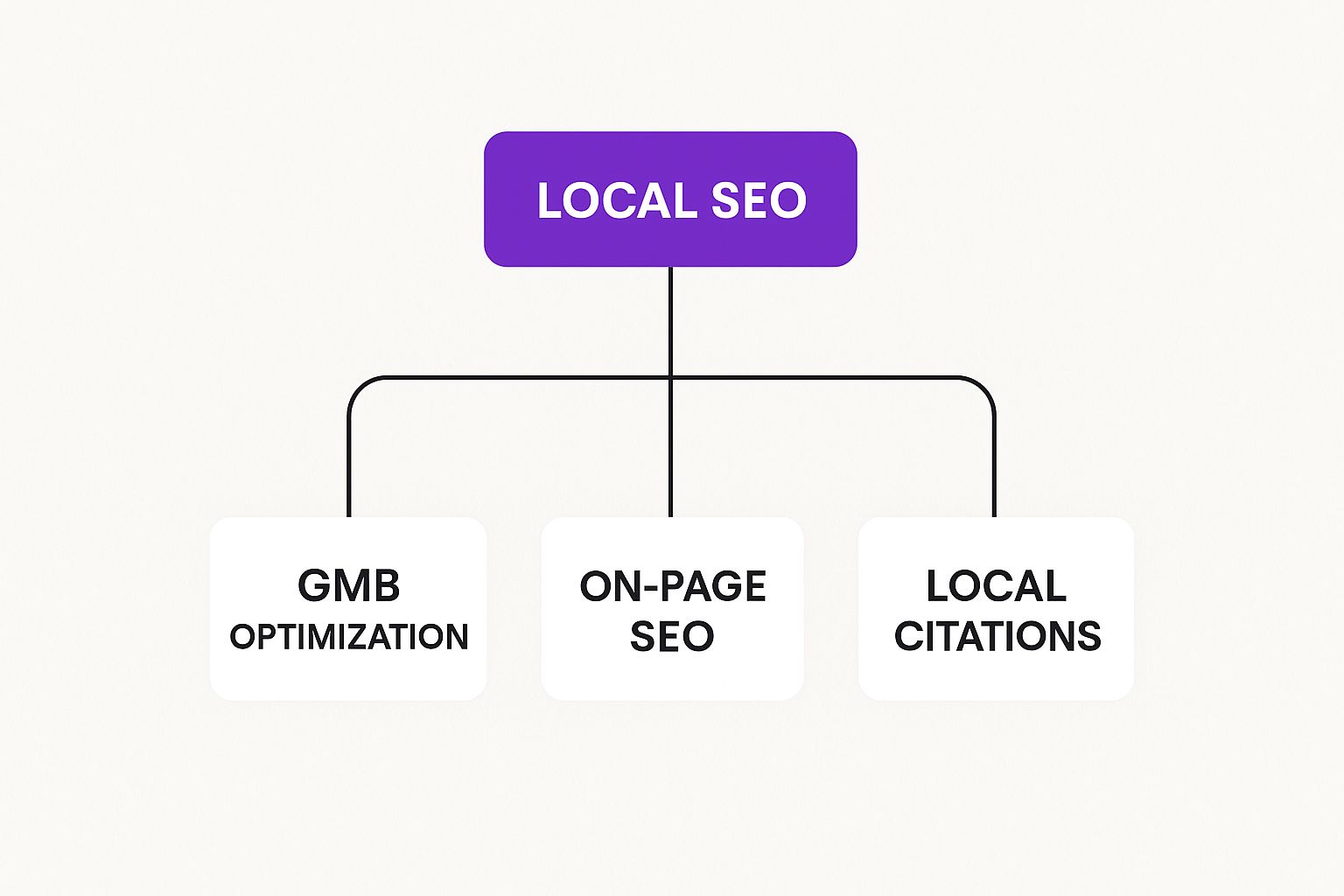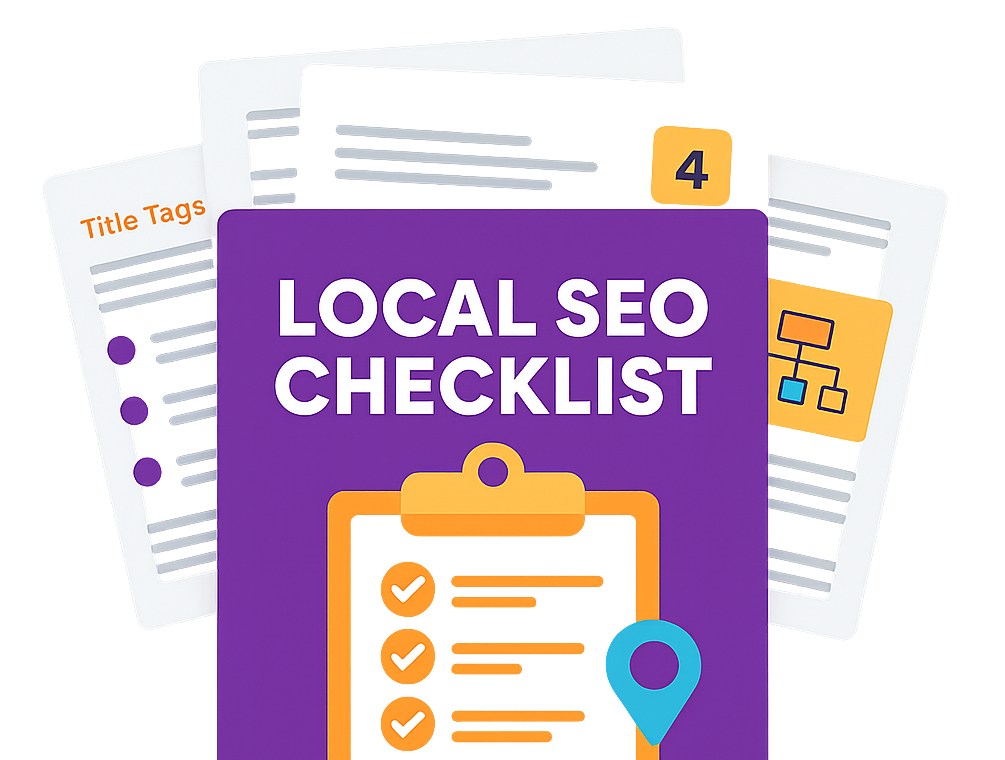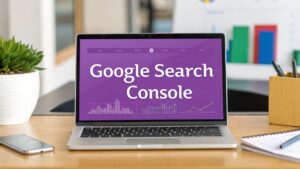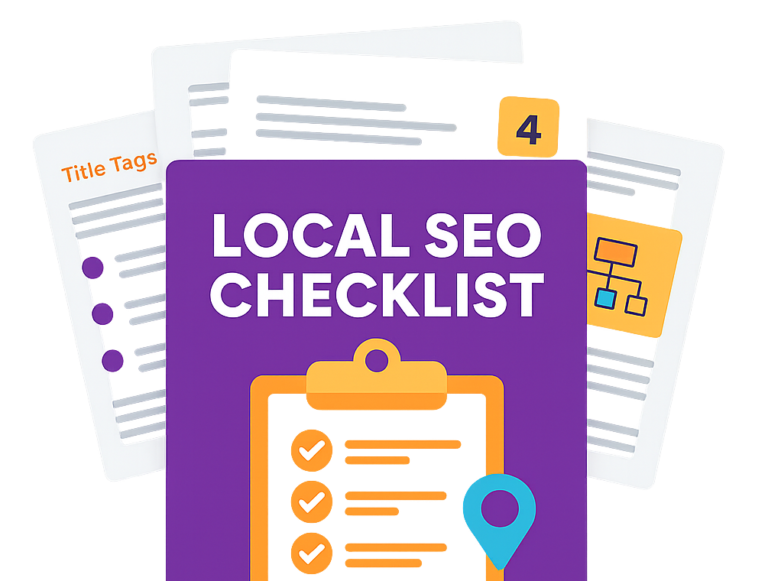Local SEO for a medical practice is all about making sure your clinic shows up when potential patients in your area search on Google. It's a focused strategy that zeroes in on your Google Business Profile, location-specific content on your website, and consistent listings in online directories. The goal? To be the first name people see for searches like "GP near me".
Why Your Practice Needs Local SEO
Think of it this way: if your trusted local clinic was tucked away on a side street with no sign, nobody would find it. In the digital world, that’s exactly what your practice looks like without a strong local SEO strategy.
For UK medical practices, a solid local online presence isn't just a "nice-to-have" anymore. It's a cornerstone of how you find new patients, build trust, and stay visible right where people are looking for you.
The Shift to Digital-First Healthcare Searches
Patient behaviour has changed for good. Gone are the days of relying purely on word-of-mouth or a Yellow Pages ad. Today, when people need care now, they turn to Google. Being there in those crucial moments is how you connect with patients actively looking for the services you offer.
In the UK, this digital-first approach means private practices can't afford to be invisible online. A huge number of UK patients now use Google and other directories to find private doctors. This shift means that getting your local optimisation right can make a massive difference to your visibility and patient numbers.
Your digital 'high street' is the top of Google's local search results. If you're not there, you're missing out on a huge and growing group of potential patients.
Local SEO isn't just a technical checklist. It's about positioning your practice as the most visible, trusted, and convenient option for people in your community, right when they need you most.
To get that visibility, a successful strategy needs to bring together several core elements. This diagram breaks down the fundamental pillars you need to focus on.

As you can see, a solid local SEO plan is built on optimising your Google profile, fine-tuning your on-page website signals, and building a wider online footprint through local citations. Let's break down what each of these pillars involves.
Core Pillars of Local SEO for Medical Clinics
To get a clear picture of what's involved, this table summarises the essential components every medical practice needs to master for local online visibility. These elements work together to build a powerful and coherent local identity.
| Component | Primary Goal | Practical Tactic |
|---|---|---|
| Google Business Profile (GBP) | Dominate the Google Map Pack and local search results. | Fully complete your profile, add high-quality photos, and actively manage patient reviews. |
| On-Page SEO | Signal to Google that your website is relevant to local patients. | Create location-specific service pages and optimise title tags with local keywords. |
| Local Citations | Build trust and authority by ensuring consistent online mentions. | Get listed in reputable directories like Yell and ensure your Name, Address, and Phone (NAP) are identical everywhere. |
| Patient Reviews | Provide social proof and improve local ranking signals. | Encourage happy patients to leave feedback on Google and other relevant platforms. |
Mastering these pillars ensures that when a local patient needs care, your practice is the one they find first.
For a deeper dive into this topic, you can learn more about SEO for healthcare in our detailed guide.
Optimising Your Google Business Profile
Think of your Google Business Profile (GBP) as the digital front door to your practice. For a patient searching online for care, it’s often the very first interaction they have with you. Treating it as an afterthought is one of the biggest mistakes a medical practice can make. In fact, a well-managed GBP can be responsible for up to 70% of your organic search traffic, not just clicks to your website.
This profile is what populates the all-important Google "Map Pack" you see at the top of local search results. A complete, accurate, and engaging profile builds immediate trust and makes it incredibly simple for patients to choose you over a competitor. It’s a powerful tool for patient acquisition that demands your full attention.
This screenshot shows the main dashboard where you can start to manage and boost your practice's visibility.

From here, you control all the critical information patients need—from your opening hours to the specific services you offer—directly influencing how you show up in local searches.
Claiming and Verifying Your Practice
First things first: you need to claim and verify ownership of your profile. This is how you prove to Google that you’re the authorised representative of the practice, giving you full control over what patients see. Verification is usually done via a postcard sent to your clinic's physical address, but it can sometimes be done with a phone call or email.
Once you're verified, you can ensure every last detail is accurate. This isn't just about getting the basics right; it's about protecting your reputation. Google allows user-submitted edits, which means anyone can suggest a change to your hours or address. Without verified control, that incorrect information could go live, leading to frustrated patients and a damaged reputation.
Meticulously Completing Every Field
A half-finished profile sends a terrible signal to both Google and prospective patients. It’s absolutely essential to fill out every available section with as much detail as you can, paying close attention to the healthcare-specific fields.
Your optimisation checklist should include:
- Practice Name, Address, and Phone Number (NAP): This must be 100% consistent with the details on your website and other online directories. Any small difference can confuse search engines.
- Categories: Choose the most specific primary category you can (e.g., 'General Practice Doctor') and then add relevant secondary ones (e.g., 'Medical Clinic', 'Walk-In Clinic').
- Services and Specialisms: Don't be vague. List every service you offer, from routine check-ups to specialised procedures. Use the exact language your patients would use when searching.
- Accessibility Information: Clearly state if your clinic has wheelchair access, accessible toilets, or other facilities. This is vital information for many patients.
For a deeper dive, our guide on Google My Business optimisation walks you through even more detailed steps.
Think of your GBP as a mini-website hosted directly on Google. The more complete and helpful it is, the more Google will trust it and show it to people searching for care in your area.
The Power of Professional Visuals
First impressions are overwhelmingly visual. Your GBP allows you to upload photos and videos, and this is a non-negotiable part of building trust. Snaps taken on a mobile phone in poor lighting just won't cut it.
Invest in high-quality, professional photographs of:
- Your Clinic's Exterior: This helps patients recognise your building when they arrive.
- The Reception and Waiting Area: A clean, welcoming space can instantly ease patient anxiety.
- Treatment Rooms: Showcase your modern, professional, and sterile facilities.
- Your Team: Friendly, professional headshots of your doctors and staff put a human face to your practice.
Adding fresh photos regularly keeps your profile active and shows patients that your practice is current and well-maintained.
Engaging Patients with GBP Posts and Q&A
Beyond the static information, GBP has dynamic features that let you engage with your community. GBP Posts are like mini-blog entries that appear right on your profile. You can use them to share health tips, introduce a new staff member, or announce changes to your services.
The Questions & Answers (Q&A) feature is just as important. Patients can ask questions directly on your profile, and here's the catch—anyone can answer. It's critical that you monitor this section proactively to provide accurate, authoritative answers yourself. You can even get ahead by adding your own common questions and answers to address things like parking, insurance, or appointment procedures. This establishes your practice as the most helpful and reliable choice in the neighbourhood.
Turning Your Website Into a Local Authority
If your Google Business Profile is the digital front door to your practice, think of your website as the reception area, consulting rooms, and patient library all rolled into one. It’s where potential patients go to dig deeper—to learn about your services, meet your team, and ultimately, decide you’re the right choice for their care. For local SEO to work, your website needs to be perfectly organised to build trust with both people and search engines.
This is where on-page SEO comes in. It’s the process of structuring your website’s content and technical bits and pieces to clearly signal your expertise and, crucially, your local relevance. It’s like putting up the best possible signposting within your digital clinic. Get it right, and when Google’s crawlers pop by for a visit, they’ll instantly understand who you are, what you do, and which community you serve.
Uncovering What Local Patients Are Searching For
Before you touch a single page, you have to get inside the heads of your potential patients. What are the exact words and phrases they’re typing into Google when they need medical help? This is the absolute foundation of local keyword research.
General medical terms are a start, but local searches are far more specific. A patient isn’t just looking for a "dermatologist"; they’re searching for a "private dermatologist in Manchester" or a "skin clinic near Liverpool Street." Their intent is crystal clear: they need help, and they need it locally.
To build a solid keyword list, think along these lines:
- Service + Location: Combine your specialisms with your city or town (e.g., "physiotherapy services in Bristol," "private GP appointments in Cambridge").
- Condition + Location: Target patients who already have a diagnosis and need a specialist (e.g., "endometriosis specialist in Leeds").
- "Near Me" Variants: You don't need to awkwardly stuff "near me" into your text. Instead, structure your site with clear location signals, and Google will connect the dots for these high-intent searches.
Doing this research gives you a blueprint for your content, ensuring you build pages that directly answer the real questions your local community is asking.
Creating Dedicated Location and Service Pages
One of the most effective ways to signal your local authority is to create dedicated pages for each of your key services and—if you have multiple clinics—each location. A single, generic "Our Services" page just won’t cut it anymore.
Imagine a potential patient lands on a page titled "Sports Injury Clinic in Chelsea." They instantly know they’re in the right place. That page should detail the specific treatments you offer, introduce the practitioners who specialise in sports injuries, and have the Chelsea clinic's address and contact details front and centre.
A dedicated, location-specific service page acts as a powerful local landing page. It tells Google, "For this specific service in this specific area, we are the authority," dramatically increasing your chances of ranking for relevant local searches.
This targeted approach lets you weave your keywords—like "Chelsea sports physiotherapy"—naturally into the page titles, headings, and body copy. The result is a highly relevant and genuinely useful resource that converts visitors into patients.
The Critical Importance of NAP Consistency
We mentioned this for your Google profile, and it’s just as vital for your website. Your Name, Address, and Phone number (NAP) details must be perfectly consistent. This is a non-negotiable rule in local SEO.
Your NAP should appear identically on every single page of your website, usually in the footer or header. This consistency acts as a constant, reliable signal to search engines, verifying your physical location and cementing your connection to the local area. Even a tiny variation, like writing "St." instead of "Street," can muddy the waters and weaken your local authority signals. For more advanced techniques, our guide to local SEO strategies offers further insights.
Beyond just creating compelling content, it's vital to ensure your website offers a smooth and intuitive experience. A clunky site can send visitors running, which tells search engines your practice isn't a valuable resource. Understanding why visitors leave and implementing effective strategies to lower your website's bounce rate can keep potential patients engaged and on your site.
Building Trust With Citations and Reviews
In healthcare, trust is everything. When a patient is looking for a new medical practice, they’re not just shopping for services—they're searching for a provider they can depend on. Your online reputation is a direct reflection of that trust, and two of the most powerful signals you can send are through citations and patient reviews.
Think of these as the digital version of word-of-mouth. They provide the social proof and consistency that both search engines and potential patients need to see before they’ll even consider picking up the phone. Getting this right is fundamental to building a credible and trustworthy online presence.

The Power of Consistent Citations
The word 'citation' might sound a bit technical, but the concept is straightforward. A citation is simply any online mention of your practice's core information: its Name, Address, and Phone number (NAP). These mentions are a cornerstone of local SEO.
Each consistent citation acts as a small vote of confidence, telling Google that your practice is a legitimate, established entity at a specific physical location. The key word here is consistency. Even tiny discrepancies—like "St." instead of "Street"—can confuse search engines and water down your local authority.
Key directories for UK medical practices include:
- General Directories: Platforms like Yell, Thomson Local, and Apple Maps are the essential starting points.
- Healthcare-Specific Portals: Being listed on sites like the NHS directory, WebMD, and other medical portals is vital for credibility.
- Local Chamber of Commerce: A listing here strongly roots your practice in the local community.
Making sure your NAP is identical across every single one of these platforms is a foundational task that pays dividends in your local search performance.
Harnessing the Influence of Patient Reviews
While citations build foundational trust with search engines, patient reviews build it directly with people. Positive reviews are often the single most important factor a new patient considers when choosing between two otherwise similar practices. They offer authentic social proof that can dramatically influence both your rankings and your new patient numbers.
Reviews are a direct line of communication between your practice and the community. They offer invaluable insights into the patient experience and provide a public platform to demonstrate your commitment to quality care.
Actively encouraging and managing reviews is no longer optional. A steady stream of recent, positive feedback signals to Google that your practice is active, valued by its patients, and deserves a prominent spot in local search results.
Ethical Strategies for Generating and Managing Feedback
So, how do you ethically encourage patients to share their experiences? The focus should always be on making it easy for satisfied patients to leave feedback—never on offering incentives, which is against the terms of service for most platforms and can damage your credibility.
Here are a few professional and effective approaches:
- Ask at the Right Time: The best moment to ask for a review is often after a positive interaction, like a successful follow-up appointment. A simple, personal request goes a long way.
- Use Follow-Up Communications: A polite follow-up email or text message after a visit can include a direct link to your Google Business Profile, removing any friction from the process.
- Make It Visible: Include clear calls-to-action on your website and in your clinic's reception area, gently reminding patients that you value their feedback.
Responding to all reviews—good and bad—is just as important. A thoughtful response to positive feedback shows appreciation, while a professional, empathetic reply to a negative review demonstrates your commitment to patient care and can often resolve a situation publicly. To further enhance your practice's reputation and encourage positive feedback, explore effective strategies to improve patient satisfaction.
Navigating Technical SEO and UK Healthcare Compliance
A successful local SEO strategy absolutely must be built on a healthy technical foundation. Think of it this way: just as your clinic needs to be physically accessible and secure for patients, your website has to be fast, easy to navigate on any device, and completely safe. This is the heart of technical SEO.
But for medical practices here in the UK, technical excellence is only half the battle. You also have to navigate a complex web of healthcare regulations to ensure every part of your online presence is compliant. This isn't just about ticking boxes; it's about protecting patient privacy and safeguarding your professional reputation.
The Three Pillars of Technical Website Health
I like to think of technical SEO as checking a patient's vital signs. While the field can get incredibly complex, focusing on three core pillars will sort out the most critical issues that affect both how users experience your site and how Google ranks it.
These three pillars are:
- Website Speed: A slow-loading site is the digital version of a packed waiting room. Patients will simply get fed up and leave, and Google notices that. Optimising your image sizes and streamlining your website's code are essential for keeping things quick and responsive.
- Mobile-Friendliness: The vast majority of local searches happen on a mobile phone. Your website has to offer a seamless experience on a small screen—with easy-to-read text and tappable buttons—or you're waving goodbye to a huge number of potential patients.
- Security (HTTPS): For any medical practice, a secure website is completely non-negotiable. An HTTPS certificate encrypts the data shared between a patient's device and your site, which is crucial for protecting sensitive information sent through contact forms or appointment requests.

Navigating UK Healthcare Advertising and Data Rules
Beyond the technical nuts and bolts, your practice must stick to strict UK guidelines on data privacy and advertising. Failing to comply can lead to significant penalties and, perhaps worse, a serious loss of patient trust. Getting these rules right is fundamental to any marketing you do.
The timeline for seeing real results from healthcare SEO in the UK is a marathon, not a sprint. You'll usually start seeing gradual improvements within 3 to 6 months of consistent effort. However, achieving substantial, lasting results typically takes a commitment of 6 to 12 months or more.
Here are the key compliance areas to keep on your radar:
- General Data Protection Regulation (GDPR): You have to be completely transparent about how you collect, use, and store patient data. This means having a crystal-clear privacy policy and getting explicit consent before you collect any personal information.
- Advertising Standards Authority (ASA): Any claims you make on your website must be medically accurate, backed by evidence, and never misleading. Steer clear of promising cures or guaranteeing results.
- Content Accuracy and Sourcing: All medical information you publish should be responsibly sourced, up-to-date, and ideally, reviewed by a qualified medical professional. This builds your authority and ensures you're providing safe, reliable advice.
When looking at digital tools and services, remember that data security and patient privacy are paramount. It's vital to choose HIPAA compliant cloud solutions that meet these stringent security standards.
A technically sound and fully compliant website does more than just rank well. It builds a foundation of trust that reassures patients they are in safe, professional hands, both online and in your clinic.
How to Measure Your Local SEO Success
So, you’ve put in the work. How do you know if your local SEO is actually bringing new patients through the door? It’s not about guesswork or just watching your website traffic go up. The real test is seeing a clear return on your efforts, and that means focusing on the numbers that matter.
Success is all about connecting your online optimisation to real-world results. You need to track the metrics that show genuine patient interest and action, proving that your investment of time and resources is actually paying off.
Identifying Your Core KPIs
First things first, you need to define what a "win" actually looks like for your clinic. For most practices, it’s not about the vanity metric of ranking number one. It’s about generating new patient enquiries. Simple as that.
Your most important KPIs will almost certainly include:
- Local Search Rankings: Keeping an eye on your position for high-intent searches like "private GP in Cambridge" shows you exactly how visible you are to potential patients who are ready to book.
- Google Business Profile (GBP) Actions: This is where the magic happens. Track the number of clicks-to-call, requests for directions, and clicks through to your website—all coming directly from your GBP listing.
- Website Conversions: This is the bottom line. Measure how many people are booking appointments online, filling out new patient forms, or calling the number listed on your site.
These metrics draw a straight line from your SEO activities to actual patient acquisition. For a structured way to keep on top of everything, our comprehensive local SEO checklist will make sure you’re not missing any essential tracking points.
Essential Measurement Tools
You don't need a boatload of expensive software to get started. In fact, two free tools from Google will give you almost everything you need to see what’s working.
Google Search Console tells you what search terms patients are actually typing in to find you and how your site is performing in the search results. Meanwhile, Google Analytics 4 shows you what they do once they land on your website, tracking their journey from first click to final conversion.
When you use these tools together, you get the full picture. You can see how a search for "physiotherapy near me" led a user to your website, where they then booked an initial consultation. That direct link between search visibility and a new patient is the ultimate measure of success.
The financial impact can be huge. For example, dental practices in the UK have seen incredible results, lowering their patient acquisition costs by 60-80% compared to what they were spending on paid advertising. By integrating tools like Google Analytics 4 with call tracking and a finely tuned Google Business Profile, they're attracting high-intent patients far more effectively. You can find more insights on dental SEO in the UK on dominatedental.com. This data-driven approach doesn't just feel good—it demonstrates tangible practice growth and gives you the confidence to make smarter decisions with your marketing budget.
Still Got Questions?
Diving into local SEO for your medical practice can feel a bit overwhelming. Let’s tackle some of the most common questions we hear from UK practice managers, with clear, straightforward answers to help you shape your digital strategy.
How Long Until We See Results from Local SEO?
While you might spot small improvements in your online visibility within 3-6 months, landing substantial, lasting results from local SEO is more of a long game. It usually takes a sustained effort of 6 to 12 months.
That timeframe is realistic for getting your Google Business Profile fully dialled in, refining your website, and building a solid foundation of local citations and positive patient reviews. Think of it as a long-term investment in your practice's digital health, not a quick fix. Consistent, well-executed local SEO builds momentum, leading to more sustainable growth in patient enquiries over time.
Can I Manage My Clinic's Local SEO Myself?
It’s definitely possible for a practice manager to handle the basics. Managing your Google Business Profile, encouraging patient reviews, and making small website updates are all perfectly achievable tasks.
However, the more complex side of things—like technical SEO, deep keyword research, and keeping up with Google's constant algorithm changes—often requires specialist expertise. Many practices find a hybrid approach works best: handling daily updates in-house while partnering with an agency for the overarching strategy, technical execution, and link building.
A common mistake is underestimating just how much time effective SEO takes. While you can manage the fundamentals internally, competing in a busy local market often demands dedicated, professional attention to really get ahead.
Is Local SEO Better Than Social Media for Getting New Patients?
For attracting new patients with an immediate need, local SEO is more critical. When people are actively looking for a healthcare provider right now, they turn to Google. They have a specific problem and they need a local solution, fast.
Social media, on the other hand, is brilliant for building your practice's brand, sharing helpful health info, and engaging with your community over the long term. It builds familiarity and trust before a need arises.
Both are valuable, but for capturing patients at the very moment they decide to seek care, a strong local SEO presence is the priority.
Ready to turn local searches into new patients? The team at Bare Digital provides a free, no-obligation SEO Health Check to identify your biggest opportunities for growth. Discover how our specialist strategies can boost your practice's visibility and attract the patients you want to serve. Get your free SEO proposal today.








